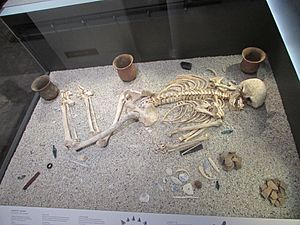Amesbury Archer facts for kids
Quick facts for kids Amesbury Archer |
|
|---|---|

Displayed in the Salisbury Museum
|
|
| Discovered | May 2002, Amesbury |
| Present location | Salisbury Museum |
The Amesbury Archer is the name given to a man from the early Bronze Age. His grave was found in May 2002 near Stonehenge, in a town called Amesbury. He lived around 2300 BC and was middle-aged when he died.
Contents
Who Was the Amesbury Archer?
The Amesbury Archer wasn't a typical archer as we know it today. He got his nickname because many arrowheads were buried with him. His grave held more treasures than any other early British Bronze Age burial. It even included the oldest gold items ever found in England! These special belongings showed he was a very important and powerful person during the Bronze Age.
We don't know his real name. Scientists believe he was likely a man, probably between 35 and 45 years old when he died.
Amazing Treasures from the Bronze Age
What makes the Amesbury Archer so special is the incredible collection of items found in his grave. This wasn't just a simple burial. It was a grand display of wealth and importance. This shows the Archer held a very high position in his society.
Here's a list of what archaeologists found:
- Two Beaker pots: These were not ordinary drinking vessels. They were large, beautifully decorated pots. They are typical of the Beaker culture from the Bronze Age. Their style shows they were carefully made and very important. One pot was slightly damaged, suggesting it might have been used, not just for display. These pots help us know the Archer lived around 2470–2340 BC.
- Four arrowheads: These were made of flint. They are why he is called the "Archer." We don't know how much he used archery. But these arrowheads show that hunting or warfare was important in the Bronze Age. A skilled artisan likely made them.
- A pair of bronze daggers: These daggers were likely used for ceremonies. They were symbols of power and authority. Their presence further proves the Archer's high social standing. The bronze probably came from far away. This shows the Archer had access to valuable goods and trade routes.
- A stone axe: This tool was probably used for cutting down trees. It suggests that even with his high status, the Archer might have done practical tasks. The type of stone used can tell us where the Archer might have traveled or traded.
- A gold hair ornament: This small gold ornament was the most amazing find. We aren't sure exactly how it was used. It might have been worn in his hair. This suggests he cared about personal adornment. Finding gold shows he had access to rare and precious materials. This was likely a very important item, showing his wealth and influence.
- Other finds: Smaller artifacts were also found. These included pieces of bone tools and animal bones. The animal bones tell us about the Archer's diet. Many were from animals raised for food. They also give clues about the local environment.
Where Did the Archer Come From?
Scientists used special methods to learn about the Archer's life. One method is called isotopic analysis. It looks at the chemicals in bones. This showed some amazing facts! The analysis revealed the Archer grew up in the Alps. That's very far from Amesbury! He might have moved to Britain many years before he died. This evidence shows that people traveled and moved a lot during the Bronze Age.
Why Is This Discovery Important?
The Amesbury Archer's grave is super important for archaeologists. It gives us a rare look into the lives of important people during the British Bronze Age. It's not just about the cool items found. It helps us understand how society was organized. It also shows us about trade networks and daily life over 4,000 years ago.
This discovery changed some old ideas about Bronze Age society in Britain. The many rich items suggest there was more social inequality than once thought. It also shows that long-distance travel and trade were more common. The Archer's story connects Britain to other parts of Europe. It shows how societies were linked across huge distances during the Bronze Age.
Unraveling the Mysteries
Research on the Amesbury Archer is still happening. Scientists keep studying the artifacts and the skeleton. They want to learn even more about this fascinating person and their world. New technologies are always being made. These help archaeologists find more details about the Archer's life, diet, and where he came from. For example, new studies might tell us more about how the grave goods were made. They might also give a more exact age for the artifacts.
See also
 In Spanish: Arquero de Amesbury para niños
In Spanish: Arquero de Amesbury para niños

